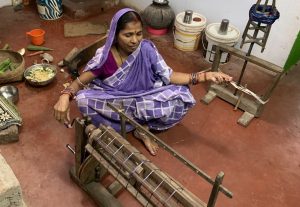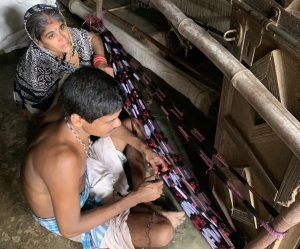Cuttack: For women of Nuapatna and Maniabandha in Cuttack district, the labour is unending. In this male-dominated weaving cluster, women make up the majority of the workforce but recognition remains elusive for them.
In the Nuapatna-Maniabandha weaving cluster, known for its Ikat or Bandha weaving and GI tag for Khandua Patta (woven in Maniabandha), there are around 300 families with each family owning one to six looms.
While the men are primarily the weavers, women do a range of tedious pre-weaving works such as designing, preparation of the yarn and looms, tying and dyeing, embellishing, and even stocking the finished product, along with taking care of the household chores. Some women weave and facilitate sales too but, their numbers are a few.
According to the Census of 2011, Nuapatna has 5,000 registered weavers, over 2,000 looms and 22 cooperative societies of weavers. Maniabandha has 3,500 weavers with 384 looms.
“A weaver can finish weaving a saree in three to four days but prior to that, it takes the woman of the family at least a fortnight to prepare the raw material,” said Nilarani Das, a 40-year-old woman of Abhimanpur village within the cluster.
She is a nurse by profession in a Bhubaneswar-based private hospital but visits her village during weekends to help her husband Arjun Pal – an award-winning weaver – in tie and dye and prepare the yarn.
“Contrary to the popular belief that men are the hands behind the beautiful sarees woven in Nuapatna and Maniabandha, it is the entire family including the women who contribute to the handloom sector. Even if women are not weaving, they are the most important part of the allied workforce as it involves the entire family,” she says.
Gayatri Kundu, an 18-year-old college-going girl from Abhimanpur village, says more than half of the women in her village are illiterate which forces them to be heavily dependent on men of the families who are also considered owners of the looms. “This is why, they have no say when it comes to the business aspect of this sector or even ownership of designs,” says Gayatri who weaves along with her father when she is not in her college.
Her family sells the finished products, be it sarees or dress materials, to mahajans (middlemen). “Mahajans provide us with the raw material and we weave the sarees for them. They pay us `700 to `800 for our labour. It takes me at least 10 days to complete a silk saree. With this meagre sum of money, there is hardly anything that I earn from weaving. But I do it for the sake of my family,” she adds. And that’s the story of almost every woman in the cluster.
The Ministry of Textiles offers 100 per cent subsidy to women weavers for construction of individual work sheds. However, in this area, there are hardly any women who have come forward to avail this benefit. Almost all the work sheds are owned by men, said Subhadra Devta, another weaver.
The women said the State government which has been proactive in providing aid to weavers, should also start women-specific measures to see that they too enjoy the benefits including Bunakar pension. “There is a need to make us visible in this sector and have more women-led cooperative societies,” Devta added.
(The story is a part of UNICEF-SAWM Mentorship Programme for Young Women Journalists of Odisha).

Comments are closed.